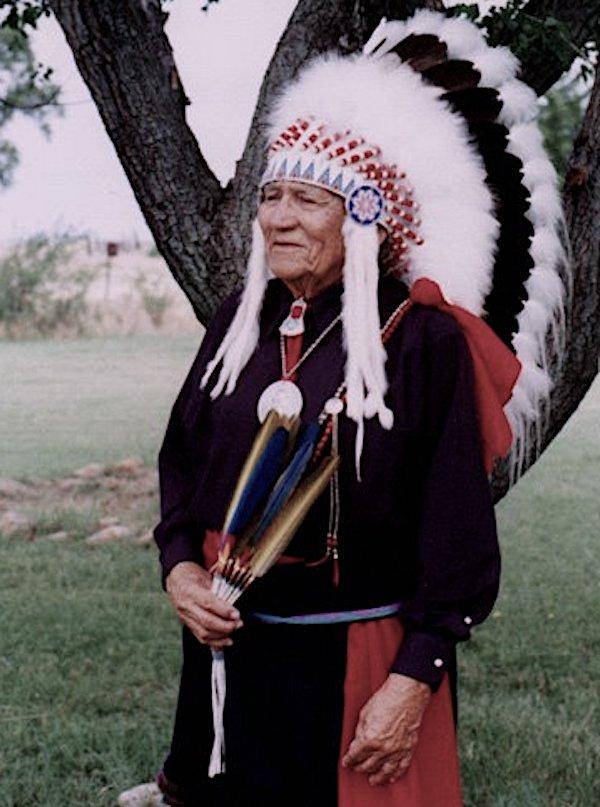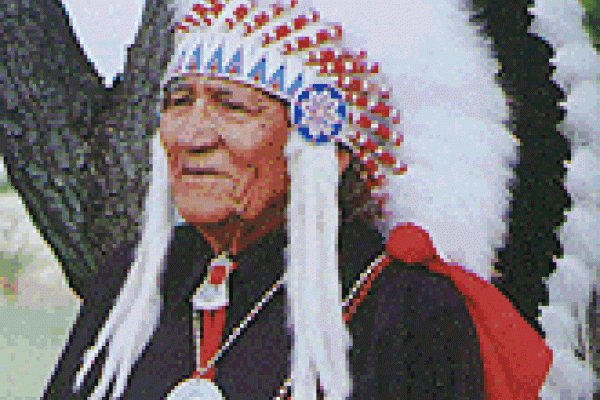Fred Tsoodle

Photo courtesy of the artist
Bio
The Kiowa of southwestern Oklahoma have long been known as great singers and composers of songs. These songs range from traditional healing and gourd dance songs to more modern intertribal pow wow songs. Fred Tsoodle, while conversant in many of these musical traditions, specializes as a song leader of a unique repertoire of Kiowa sacred Christian music. The tradition of sacred Christian singing began among the Kiowa people in 1893 when missionaries came to southwestern Oklahoma. The earliest sacred song was a Christmas song composed by Deacon Gotebo, the first Christian convert at Rainy Mountain Baptist Church. The Kiowa say that there is a song for every religious occasion commemorating the holy holidays as well as significant stages in life such as birth, baptism, and death. There are probably more than 200 of these hymns, each with a unique tune and lyrics in the Kiowa language. The primary way of keeping these songs and performing them is through human memory. As the recognized song leader in the Rainy Mountain Kiowa Indian Baptist Church, Fred Tsoodle is the performer and keeper of this valuable cultural repertoire. Pulitzer prize-winning author N. Scott Momaday reinforces the importance of Tsoodle's work: "These hymns constitute a unique expression of American folk and religious music, bringing together as they do the deepest and most human elements of both of these rich traditions. The result is a unique and profoundly spiritual American music. It is one of our national treasures and it deserves to be preserved for its own sake. Fred Tsoodle has done more than anyone I know to preserve it."
Interview with Mark Puryear
NEA: What was your reaction when you heard the news?
MR. TSOODLE: I didn't really know what was happening. I was shocked, really surprised. I've never gotten anything like this in my life. I had to sit here for awhile and think about it. I thought about the others that have gotten this and here they had picked me. It's really something.
NEA: I read the article about you in the Oklahoma paper ["Kiowa Elder Seeks to Save Sacred Songs," Daily Oklahoman, August 4, 2001.] It's clear you've worked hard.
MR. TSOODLE: I'm just trying to preserve what's fading. We're losing our language, we losing our songs. This is something that I just fell into with encouragement from some of the elderly people here. My in-laws, in fact, and a couple of other elderly men encouraged me. They'd start singing. You know, it's done mostly by memory, you can't write it down. They're trying to write some of it down now.
NEA: That's what I understand. Some of the language is hard to translate.
MR. TSOODLE: I don't know how they do it. The Kiowa language is really hard. You have to learn it, you have to know it well. And we have so many songs. We have songs for every occasion. For church, for the sad times, the happy times, we even have a birthday song. The elderly people even composed two military songs for the soldiers that were oversees, a prayer for them in song. We've got Christmas songs, baptism songs, invitation songs, lullabies. There are so many of them. But they're not written down. You have to memorize them.
NEA: Why do you think your artistry and your skill are valuable to your community?
MR. TSOODLE: Because we've wanted to preserve these beautiful songs. Nowadays, I can record them on tape and explain what the words mean and the younger people can come along and memorize them. I'm happy that we've been able to record them. And I'm hoping that they will be able to write them. But I don't know how, the sounds are so different, the sounds are hard.
NEA: What are the biggest challenges you find in practicing or sustaining your art form?
MR. TSOODLE: Again, the most important part is keeping it going. It's just like our language. We're even losing our language. Unless they try to preserve the language, it's going to disappear when my generation is gone. My children understand the Kiowa language but they don't speak it. They take the easy way out. We speak English with them rather than Kiowa.

NEA: Is it being taught in any schools?
MR. TSOODLE: They're trying to start it over in Chickasha, Oklahoma. They're doing a pretty good job. And they had some kind of program here for the seniors, but I told them it was a big mistake teaching the elderly people. They shouldn't teach the elderly - they need to reach the little ones. And they had people in charge of the program who didn't really understand Kiowa themselves. They should get somebody in there that knows Kiowa fluently and speaks English too, and teach it from there.
NEA: Yes, somebody that's really bilingual.
MR. TSOODLE: They teach the elderly people, but even the elderly people are not speaking it much. My wife and I speak it all the time at home. We speak English too, but that's what's happening with our tribe. Kiowa was all we spoke when I was growing up. Everybody spoke it fluently, but now it's fading away. The elderly people don't teach the young people. They don't speak it in their homes.
I keep saying to people that we've got to preserve everything that's Indian. We need to preserve our language and all that. But we're getting away from that, which is really sad.
NEA: What advice would you give students or young people?
MR. TSOODLE: Learn the language. Learn the songs. Not just the religious songs, but also other songs that we sing. Listen to them and try to learn.
NEA: Who were the influences on you when you were learning?
MR. TSOODLE: I've been singing most of my life, since I was a little boy. My father-in-law and mother-in-law, Mr. and Mrs. Milton Toyebo, influenced my church singing. My father-in-law's brother, Louis Toyebo, also influenced me. And another gentleman, Allan Tsontequoy, an elderly man, used to come up to my house here and we'd sit outside or we'd sit in the car and sing. He'd tell me about when it's appropriate to sing specific songs and things like that. My grandmother taught me a lot of songs.
Then I got involved in this pow-wow. I used to sing around a drum with this group of men for pow-wows, a drum group. I used to war dance and I got involved in the gourd dancing, which is all over the country now. I helped revive that back in 1953.
NEA: Was that a Kiowa dance originally?
MR. TSOODLE: It was the main one I grew up with.
Let me tell you the story about how gourd dancing was revived. My grandfather was one of the leaders of what we called the Kiowa Gourd Clan. We had our last big gourd dance in the summer of 1941 in Carnegie, Oklahoma, at my grandfather's place. We had invited another tribe - the Otoo tribe from northern Oklahoma that we'd made friends with - to come and do the gourd dance with us. Then my grandfather died that winter.
I left home after he passed away and left for the service soon after that. I was overseas from '42 to '45. When I got back they had an honor dance for me here in Carnegie and I was surprised that they were not gourd dancing. They had other dances, but no gourd dance.
Some years later, in 1953, I heard some old men singing some gourd dance songs. We have an Indian Fair over here, so after hearing the men sing my wife and I sat down and decided we should get some of the elderly men from our tribe to perform at the fair in front of the grandstand. All the different tribes around here put on some kind of a program at the Fair. They compete against each other, show the dances they have and so on. So we decided to put this on. I knew there were people who knew the dance. We had to look for elderly men who knew the dance. We found some of the ones I'd seen when I was young. I asked and they agreed to perform.
But some didn't have costumes because they had put them away, thinking they would never be used again. But they got them and we presented the dance at the fair in front of the big grandstand. It was the first time it had ever been performed there. It was a beautiful sight because we had them all in their regalia and all that. The crowd was just quiet and pretty soon I heard some women crying.
NEA: It moved them to tears...
MR. TSOODLE: Oh yes. It was something they thought was lost forever. I helped revive that and I'm really glad to this day. And now they're dancing it all over the United States.
NEA: You're teaching the young kids. How do you do that? Is it a structured class or just at church?
MR. TSOODLE: We had this Bible school this summer and we had a whole group down. We taught them as a group. They were real good. I taught them three or four different songs. They could really sing. And I tried to explain what the songs meant, the words and so forth.
I sing at the church and try to help some of the middle-aged and the elderly. They sing now, and I try to tell them what the words mean. They're really really responsive to the singing. They're beautiful songs. If you know the words, they really have meaning, all the songs we sing in church.
NEA: Is there a way that the National Endowment for the Arts could be of more service to you and your art form or your community?
MR. TSOODLE: To preserve the songs, we have to tape them and explain them. Not only these songs but the pow-wow songs. We need to do more of that. But we get them down and they disappear, the tapes disappear. We have to figure out some way to really preserve them so we can use them and people can use them and but not them with them.
NEA: This might be something that computer technology could help - you could keep the original recordings in a special place - and just have them available on a computer that people could listen to. They wouldn't have to handle the tape.
MR. TSOODLE: That's something that would really help. We could preserve the songs. Maybe the tapes could be put in our museum.

